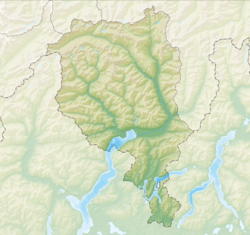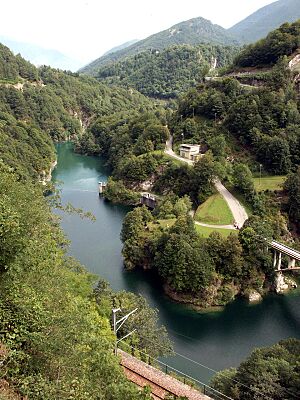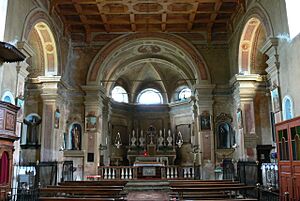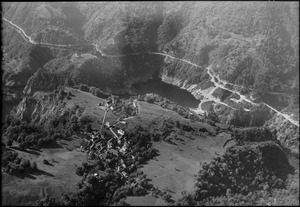Palagnedra facts for kids
Quick facts for kids
Palagnedra
|
||
|---|---|---|
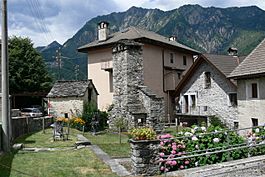
Palagnedra village
|
||
|
||
| Country | Switzerland | |
| Canton | Ticino | |
| District | Locarno | |
| Area | ||
| • Total | 16.38 km2 (6.32 sq mi) | |
| Elevation | 652 m (2,139 ft) | |
| Population
(December 2004)
|
||
| • Total | 119 | |
| • Density | 7.26/km2 (18.82/sq mi) | |
| Postal code |
6657
|
|
| Surrounded by | Brissago, Cannobio (IT-VB), Valle Cannobina (IT-VB), Intragna, Re (IT-VB) | |
Palagnedra is a charming village in Switzerland. It is located in the Ticino region, which is known for its beautiful mountains and Italian-speaking culture. Palagnedra used to be its own town, but now it is part of the larger Centovalli municipality.
Below the village, you can find the Lago di Palagnedra. This lake was created by a dam on the Melezza river.
Contents
A Glimpse into Palagnedra's Past
Palagnedra has a long history. It was first written about in the year 1379. Back then, its name was Pallagnidrio.
Palagnedra's Role in the Centovalli Valley
During the Middle Ages (a time from about 500 to 1500 AD), Palagnedra was very important. It was the main center for managing the Centovalli valley. It was also the religious center for the area.
In the 1500s, Palagnedra became part of the Locarno and Ascona regions. Later, it was part of the Locarno bailiwick. A bailiwick was like a district ruled by a special official. In 1864, the village became independent.
The Historic San Michele Church
The beautiful church of San Michele was built a long time ago. Its construction started in 1640 and finished in 1732. It has been carefully restored several times.
This church was once the main church for the entire Centovalli valley. Inside, you can see amazing old paintings called frescoes. These artworks were created by Antonio da Tradate and are from the late Gothic period. They are very well-preserved.
How People Lived and Worked
For many years, the people of Palagnedra mostly worked in farming. They grew crops and raised animals. Starting in the 1500s, some people would travel to Italy for seasonal work. At first, many were laborers. By the 1800s, many became cooks in Tuscany.
Until the 1950s, the village was close to the Italian border. This led to people moving goods across the border, sometimes without official permission.
Between 1950 and 1952, a hydroelectric dam was built near the village. This dam uses water to create electricity. In 2005, about one-third of the jobs in Palagnedra were still related to farming.
Becoming Part of Centovalli
On October 25, 2009, Palagnedra joined with two other towns, Borgnone and Intragna. Together, they formed the new municipality of Centovalli.
A well-known family name in Palagnedra is "Mazzi." Many people in the community share this last name.
Where is Palagnedra Located?
Palagnedra is found in the Locarno district. It sits on a high, flat area on the southern side of the Centovalli valley. The area includes several smaller parts, like Bordei, Bolade, and Crup.
How Palagnedra's Population Changed Over Time
Here is a look at how the number of people living in Palagnedra has changed through the years:
| Year | Population Palagnedra |
|---|---|
| 1850 | 337 |
| 1900 | 267 |
| 1950 | 298 |
| 2000 | 92 |




